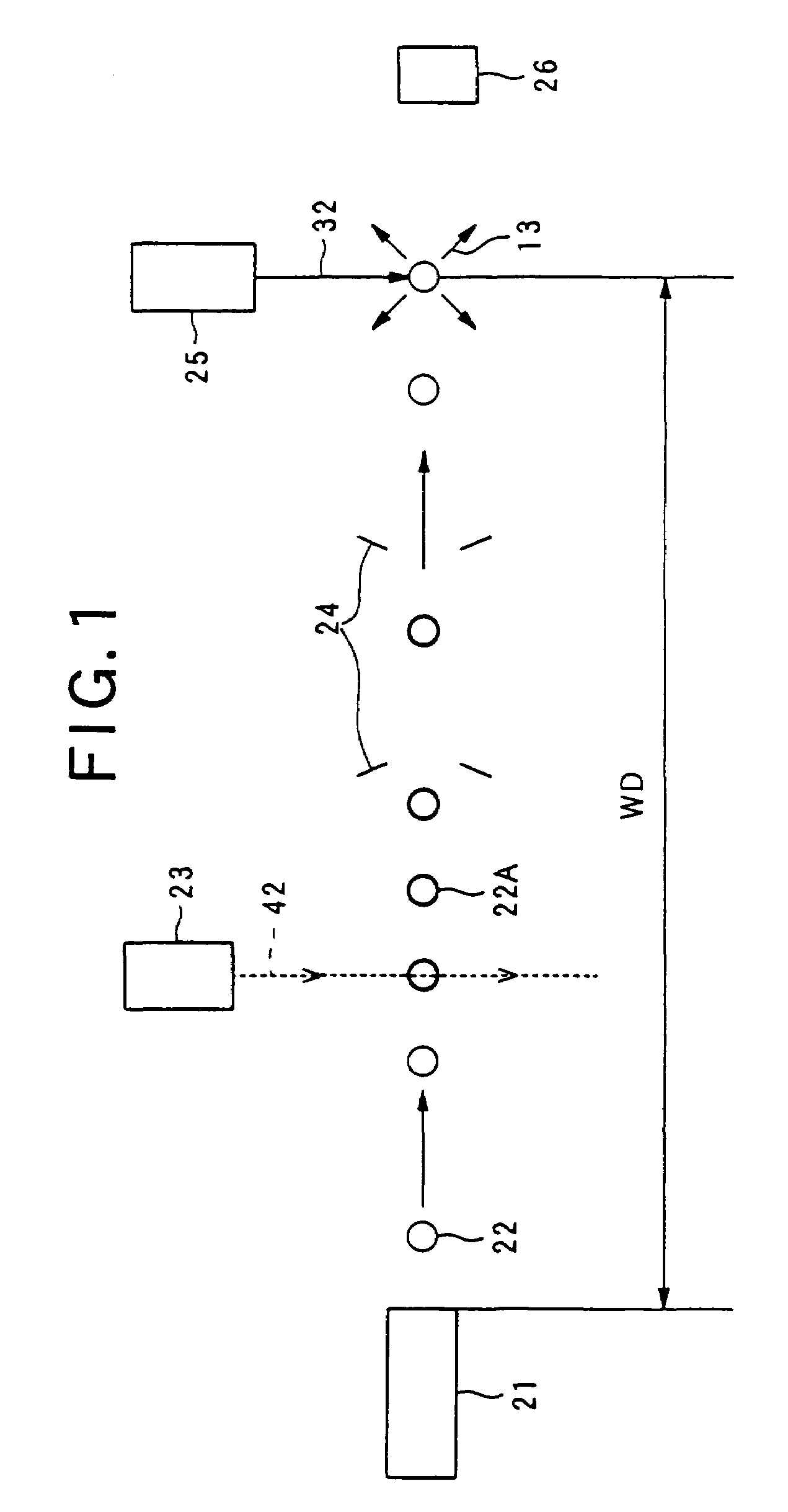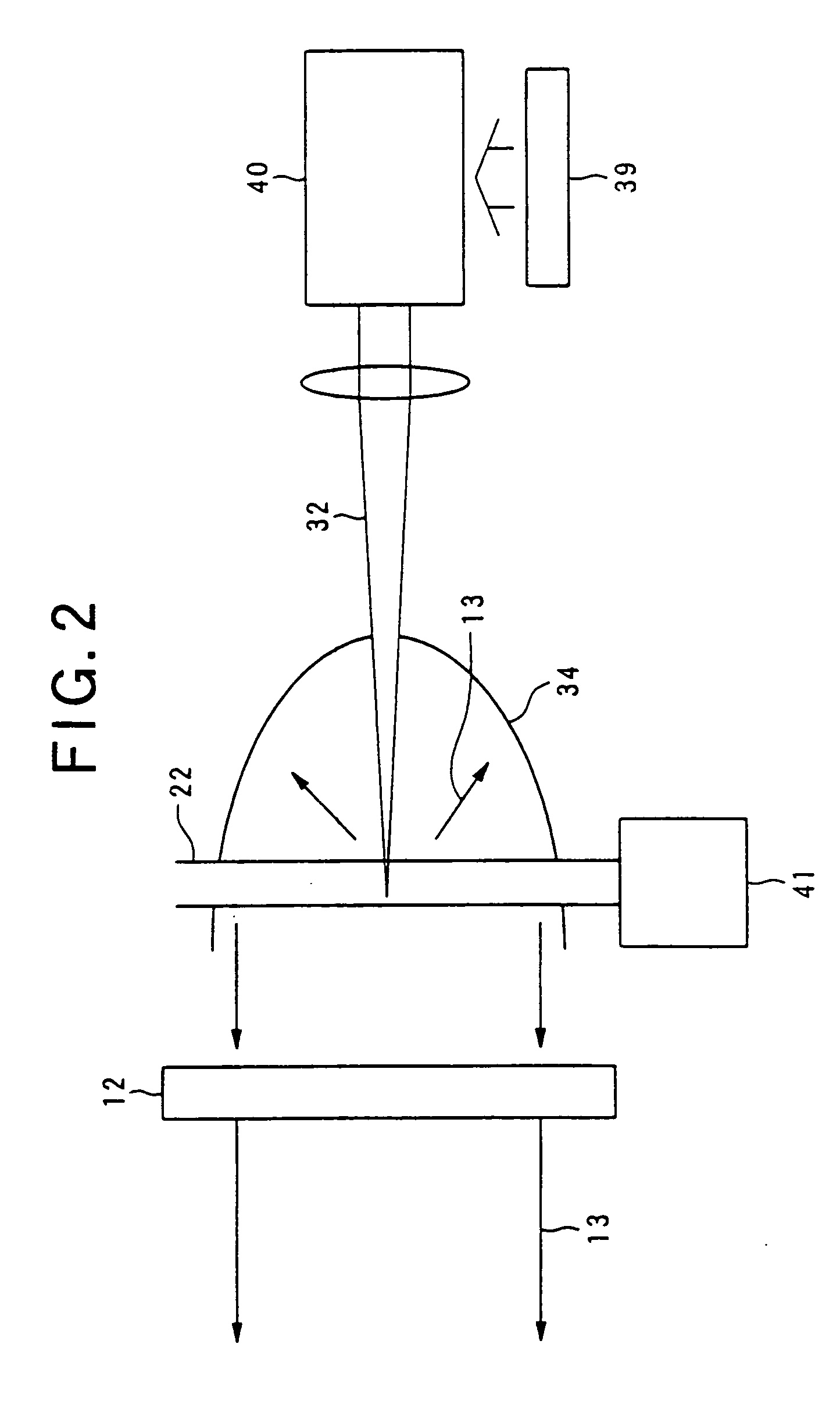Extreme ultraviolet light source
a technology of ultraviolet light and ultraviolet light, which is applied in the field of extreme ultraviolet light source devices, can solve the problems of difficult plasma conversion of all of the target b>22/b>, difficult laser irradiation, and damage to the nozzle b>21/b>, and achieves the effects of extreme ultraviolet light, increased working distance, and high outpu
- Summary
- Abstract
- Description
- Claims
- Application Information
AI Technical Summary
Benefits of technology
Problems solved by technology
Method used
Image
Examples
first embodiment
[0103]FIG. 1 shows a structural diagram of an extreme ultraviolet light source device 11 of a
[0104]For example, a piezoelectric element or the like (not shown in the figures) is disposed inside a nozzle 21 that supplies the target 22, so that the target 22 can be caused to jet at a high velocity. The target 22, which is liquefied by cooling means (not shown in the figures), is emitted from the nozzle 21, and is charged by irradiation with an electron beam 42 generated by an electron beam generator 23 while the target is traveling at the emission velocity. The material of the target 22 is liquid Xe, solid Xe, or some other liquid or solid substance. If an electron beam 42 with a diameter of approximately 100 μm is used on a target 22 with a diameter of approximately 10 μm, the entire target 22 can be irradiated by the electron beam 42.
[0105]The traveling velocity of the charged target 22A is accelerated by (for example) a van de Graaff type accelerating device 24, and is subsequently...
second embodiment
[0124]Next, a second embodiment will be described.
[0125]In the second embodiment, a carbon dioxide gas laser device with a 10 μm wavelength band is used as the driving laser device 25. The laser light is focused by an irradiation optical system on the flow path of a gas-form target 22 that is separated from the nozzle 21 by a distance of several centimeters to several tens of centimeters, so that a plasma is generated.
[0126]The plasma that is thus generated has a length of several millimeters to several centimeters. The optical axis of the focusing optical system is caused to coincide substantially with the long axis of the plasma generated on this filament, and the EUV light generated from the plasma is focused so that this EUV light is focused and transmitted to the illumination optical system 14. In this case, the light passes through the debris shield 12 so that debris is removed, and so that only the extreme ultraviolet light 13 is emitted into the illumination optical system 1...
embodiment 3
[0136]Embodiment 3 has a construction that is substantially similar to that described above; in this embodiment, the amplification stage lasers are constructed from TEA-CO2 lasers. In this case, the following merit is obtained: namely, the pulse energy can be increased to a greater value than in a case where abovementioned amplification stage lasers are constructed from CW-CO2 lasers.
[0137]In the present invention, as was described above, the target 22 can be controlled by applying a charge to clusters, or applying an electromagnetic field to a charged target 22 formed by ionizing gas molecules. Accordingly, the following effects are obtained:
[0138]6.1 A high-velocity flow of the target 22 can be generated by combining the present invention with a technique using an ion beam accelerating device 24.
[0139]6.2 The plasma generation point can be removed to a position that is distant from the nozzle 21. As a result, there is little damage to the nozzle 21, and design of the focusing opti...
PUM
 Login to View More
Login to View More Abstract
Description
Claims
Application Information
 Login to View More
Login to View More - R&D
- Intellectual Property
- Life Sciences
- Materials
- Tech Scout
- Unparalleled Data Quality
- Higher Quality Content
- 60% Fewer Hallucinations
Browse by: Latest US Patents, China's latest patents, Technical Efficacy Thesaurus, Application Domain, Technology Topic, Popular Technical Reports.
© 2025 PatSnap. All rights reserved.Legal|Privacy policy|Modern Slavery Act Transparency Statement|Sitemap|About US| Contact US: help@patsnap.com



